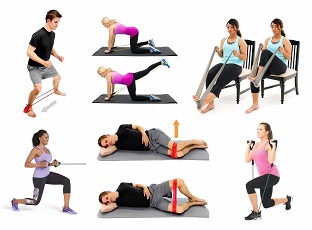- Home
- Knee Exercise Guide
- Resistance Band Exs
- Bands v Weights
Resistance Bands vs Weights
Written By: Chloe Wilson, BSc(Hons) Physiotherapy
Reviewed by: KPE Medical Review Board
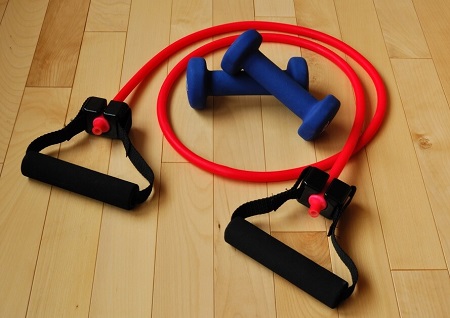
Resistance bands vs weights is the hot new topic particularly now people are looking for more ways to workout at home.
But what are these strange giant rubber bands you keep seeing at the gym or hear people talking about? How do they work?
And are they really a good alternative to dumbbells and other weights?
Well, there are pros and cons of each and when it comes resistance bands vs weights a lot of it is down to personal preference. It’s not so much that one is better than the other, there is generally a time and place for each. You can even use them both together!
Here we will look at how resistance bands and weights actually work our muscles and the pros and cons of each.
What Are Resistance Bands?
Before we look at the pros and cons or resistance bands vs weights, let’s find out a bit more about these funny bands and how they work.
Resistance bands are an elasticated exercise tool that really get your muscles working. There are a range of styles to choose from including loops, flat bands, tubes and ones with handles each available in different strengths and lengths.

By fixing one end of the band to an anchor, such as your foot, hand, a table leg or door handle, you work your muscles by pulling against the tension in the band.
Related Article: Benefits of Resistance Bands >
How Do Resistance Bands Vs Weight Work?
So what's really going with resistance bands vs weights? Now we all know that to really work a muscle, we need to load it and give it something to work against. Historically, that has always been done through using weights, be it dumbbells, free weights or various weight-lifting equipment at the gym.
Now, resistance bands have entered the mix, and who would have thought these stretchy bands would actually start to rival weights in popularity.
Let’s look at how resistance bands and weights work, their similarities and differences so you can make the right choice for you when it comes to resistance bands vs weights:
1. Constant vs Variable Resistance
The first difference with resistance bands vs weights is how they load the muscles. Simply put, with:
- Weights: the resistance is constant through the entire range of motion, it doesn’t fluctuate
- Resistance Bands: the resistance increases through the range of motion so they get gradually harder to work against
But what does that mean for you, should you use resistance bands or weights?
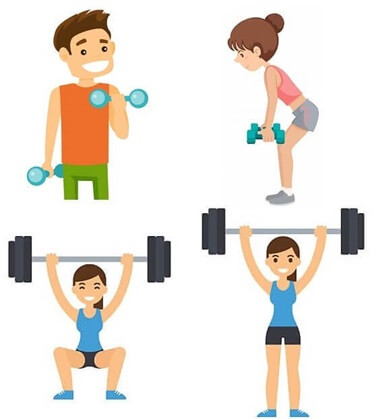
Let’s start with weights. It might seem obvious but a 2 kg weight will always weigh 2 kg!
As soon as you try to lift it, your muscles have to work hard to initialize movement, and then they keep working hard as you lift against gravity, always moving the same weight.
The resistance weight stays the same throughout the movement, it does not change.
With weights or dumbbells, you know what you are getting, and if you want real body builder muscles, weights are probably right for you.
But the disadvantage with weights is that if you want to chance the load on the muscles, i.e. the resistance, you need a completely new set of weights.
With bands, the resistance gradually increases as you move through range. The further you stretch the band, the greater the tension through the band and the more resistance it provides. Your muscles have to work harder and harder to continue the movement, working their very hardest towards the end of range.
With resistance bands you can vary the amount of resistance by simply moving your hand up and down the band to change its length. Reducing the distance between the 2 anchor points increases the stretch and thus the tension through the resistance band, which makes your muscles work harder, and vice versa. Same equipment, you just change where you hold it.
You can still build-up further like with weights for more of a challenge, you simply swap to a stronger band with a higher resistance level.
So, if you want complete control over the amount of resistance when you work out, go for weights. But if it’s graded, progressive exercises you are after, it’s a clear win for resistance bands vs weights.
2. Effect Of Gravity
The next difference between resistance bands vs weights comes down to gravity.
With weights, you are essentially always working against the downward pull of gravity. You will either be pushing weights up against gravity or controlling them on the way down. But the resistance always comes from gravity pulling the weight down.
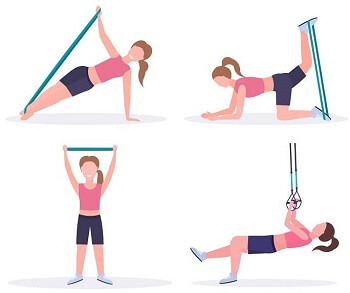
When it comes to resistance bands however, it’s different. Whatever direction you pull in, the resistance comes from the opposite direction. This means you can really simply change the direction of pull by changing the anchor point which gives a lot more options.
You could anchor the band under your feet so you are pulling upwards, in front of you to pull horizontally, above you so you are pulling down, the options are numerous.
3. How To Vary The Intensity
Another factor to consider with resistance bands vs weights is how hard you want to work your muscles, how intense a workout are you going for.
With weights such as dumbbells and barbells, you can choose how hard to work your muscles by adding or taking off weights. The limit with weights is your muscles and what weight they are capable of moving.
And if you work out in a gym, there are also loads of different weights machines to choose from to target different muscle groups.
So with weights, it really easy to know exactly what you are lifting, keep track of how many reps you can do, and if it’s feeling easy, you just simply another weight. The downside is you need access to a variety of weights – fine if you are a gym regular, but harder if you want to work out at home.

Resistance bands come in a variety of colors which provide different levels of resistance by varying the tension in the band. The greater the resistance level, the harder your muscles have to work to pull on the band.
So you pick the right colour band for you, which might vary depending on which muscles you are working. Lots of resistance bands are sold in sets where you get a range of colors so you can simply switch between bands.
You can also makes exercises easier or harder by changing the length of the band – the shorter the band, the sooner it starts stretching and thus resisting the movement, making your muscles work harder.
The limit on far you can go with resistance bands is the breaking point of the band, the point at which it is under so much tension that it splits. But that is pretty rare and for most people, this isn’t a problem as they never even get to the higher level resistance bands!
So weights and bands both offer progressive loading options with very few people maxing out on either. But if really big muscles are your end goal, then when it comes to resistance bands vs weights, weights are probably going to suit you better.
Pros & Cons of Resistance Bands Vs Weights
So we’ve looked at resistance bands vs weights and how each work to build muscle strength, but how do you choose which one is right for you?
1. Safety & Injury Risk
Safety is one example in the debate of resistance bands vs weights where resistance bands win hands down.
The most obvious reason is that if you drop a resistance band on your foot, it’s not going to hurt! But drop a weight on your foot and chances are it really will! It may even cause a serious injury.
Secondly, because the amount of tension through resistance bands gradually increases the more you pull on them, you are much less likely to suddenly overload your muscles when using resistance bands vs weights. There’s no danger of trying to pick up something that’s just too heavy for you.
Thirdly, it is much harder to overextend muscles and joints with resistance bands than weights as the elastic stretch through the band limits your range. But if you try and lift a weight that is just too heavy for you, it may push you into an uncomfortable position and could tear one of the muscles. It’s very easy to pick a weight that is just too heavy for you.
So resistance bands are much safer to use than weights as they are less likely to cause an injury, either from dropping them on your foot or from overloading your muscles!
2. Effectiveness
A systematic review carried out in 2019 looked at the effects of training with resistance bands vs conventional weights on muscle strength. This study found that “there is no superiority between training performed with elastic resistance and training with weight machines and/or free weights on strength gain”.
So that one is a tie!
3. Portability
When it comes to portability, it’s another hands down win for resistance bands vs weights. You can take resistance bands basically anywhere. They pack down extremely small, weigh next to nothing and you don’t even need much space to use them. Perfect if you are travelling or just want to keep them in your bag incase! Lugging heavy weights around is definitely less appealing!
So resistance bands are definitely better than weights if you are looking to exercise when you travel, or if you are short on space!
4. Cost
If price is an issue, then it’s cheaper to go for resistance bands vs weights. There are loads of different options available on Amazon:
- Starter Set of Resistance Bands (5-30lbs): prices from $11/£7
- Starter Set of Resistance Tubes (10-50lbs): prices from $40/£20
- Starter Set of Hand Weights (up to 10lbs): prices from $40/£30
- Starter Set of Dumbbells (35lbs+): prices from around $60/£40
#CommissionsEarned from Amazon on qualifying purchases
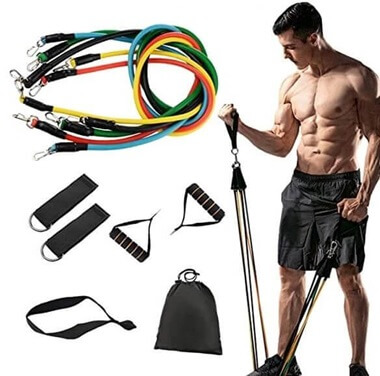
With resistance bands you can even stack them i.e. use more than one band at a time to increase the resistance e.g. stack 10, 20, 30, 40 and 50lb bands together for 150lbs of resistance.
Both are pretty durable when used correctly so they shouldn’t need replacing often. Resistance bands can split if used incorrectly or after long-term use but they are usually guaranteed for 1-2 years - most bands last much longer.
Dumbbells are more durable and are pretty hard to break - they are usually guaranteed for 2-5 years. So when it comes to cost for resistance bands vs weight, bands win for initial outlay, but it’s a win for weights for durability.
Our Verdict On Resistance Bands Vs Weights
When it comes to resistance bands vs weights, we think that resistance bands come out on top for most people because:
- Resistance bands are usually safer to use than weights. They don't hurt if you drop them on yourself and you are much less likely to injure yourself from overloading your muscles with resistance bands.
- Resistance bands are much easier to store and transport than weights. They take up less space and weight next to nothing!
- Resistance bands are cheaper than weights, but are slightly more prone to breaking - although that is rare!
- Resistance bands and weights both work muscles hard, but it's easier to change how hard you work with resistance bands. Simply changing where you hold the band can make a huge difference, rather than needing to get a whole new set of weights.
- Weights work in one direction, resistance bands can work in multiple directions. With weights, you can work harder by lifting against gravity, but with resistance bands you can simply change the anchor point to change the direction of pull giving you more control.
- With both weights and resistance bands you can vary the intensity of your workouts but there are more options with resistance bands. With weights, you can change how heavy a weight you use and how many reps you do. With resistance bands you can change which colour band you use, number of reps, how long they are and where you hold them.
Summary
Well, as we’ve seen here there are pros and cons when it comes to resistance bands vs weights. At the end of the day, a lot of it comes down to personal preference. And don’t forget, it is not an either or situation – you can use weights and resistance bands together!
Both work well at improving muscle strength, both are pretty simple to use. But unless you are a serious weightlifter, resistance bands get my vote. If you want lighter, safer, cheaper, more portable and more versatile, go for resistance bands vs weights.
Keen to get started? Check out our Resistance Band Exercises for Legs or find out more about the benefits of resistance bands.
You may also be interested in the following articles:
- Front Knee Pain
- Swelling Behind The Knee
- Knee Strengthening Exercises
- Best Knee Stretches
- Knee Pain Diagnosis Chart
Page Last Updated: 05/06/24
Next Review Due: 05/06/26
Related Articles
*Prices correct as of October 2025. All prices are subject to change. Please note we do not stock products directly and therefore have no control over price changes. See advertising policy for more information.


